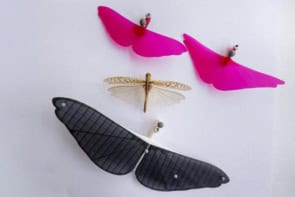Logic gates that use tiny bubbles moving in a fluid have been created by Manu Prakash and Neil Gershenfeld of the Massachusetts Institute of Technology in the US. The two gates, which perform different logical functions, could be combined to perform any computation currently done by a conventional computer, says Prakash. The researchers have also used bubble logic to create a one-bit memory for storing information and therefore have all the components necessary to build a "bubble computer" (Science 315 832).

Microfluidics is a new field of research that involves moving picolitre quantities of liquids through micrometre-sized channels. Because such tiny quantities are involved, microfluidics is ideal for studying expensive or difficult to synthesize materials such as new drugs. Large numbers of microfluidics systems can also be connected to create “laboratory-on-a-chip” systems that allow lots of chemical processes to be performed at once, speeding up the discovery of new drugs.
Although scientists know how to move and react chemicals within tiny channels, switching the direction that they flow remains a major challenge. This is usually done using “microvalves”, which rely on external magnetic fields. However, microfluidics systems could be made smaller and cheaper if this switching could be activated by the presence (or absence) of the chemicals themselves.
Now, Prakash and Gershenfeld have discovered that the direction of flow of air bubbles in a microfluidic system can be switched according to the presence (or absence) of other bubbles. When a bubble reaches a junction in a microfluidic channel, it is always pushed along the route with lower resistance to flow. If the first bubble to reach a junction moves through one channel, this channel will then have higher resistance. As a result, a second bubble arriving a short time later will always flow along the other channel.
The researchers used this property to create a very simple logical “AND-OR” gate, which switches the flow of two input bubbles depending upon their relative arrival times at the gate. Prakash and Gershenfeld also created the more complicated “INVERTER-AND” gate, in which a smaller bubble can switch the direction of larger bubble. This “gain” is an important property of electronic devices such as semiconductor transistors and could ultimately be exploited to create large-scale bubble logic devices.
Indeed, Prakash and Gershenfeld have already connected gates together to do more complicated computations such as “NOT(A) AND B”. They are now busy fabricating several chips that combine the logical gates to create large-scale processors.
The devices are also capable of storing, transporting and combining chemical compounds, and their chemical and computational capabilities could be exploited to create chips that aid in the discovery of new drugs or that search for explosives Individual bubbles can carry different chemical compounds, which means that the logical devices could be applied to two important processes of industrial chemistry – combinatorial chemistry and high-throughput screening.
Irving Epstein, a chemist at Brandeis University, told Physics Web that the technology could also be used to create cheap portable analytical devices that could be used, for example, to test for AIDS testing in remote areas or for detecting pollutants. “Given the rate of recent progress, I could imagine at least some applications becoming available within the next 2-5 years”, he said. As for bubble computers, Epstein believes that microfluidic systems may ultimately be superior to conventional computers for certain highly parallel computations that involve evaluating very large numbers of possible solutions to a problem.




